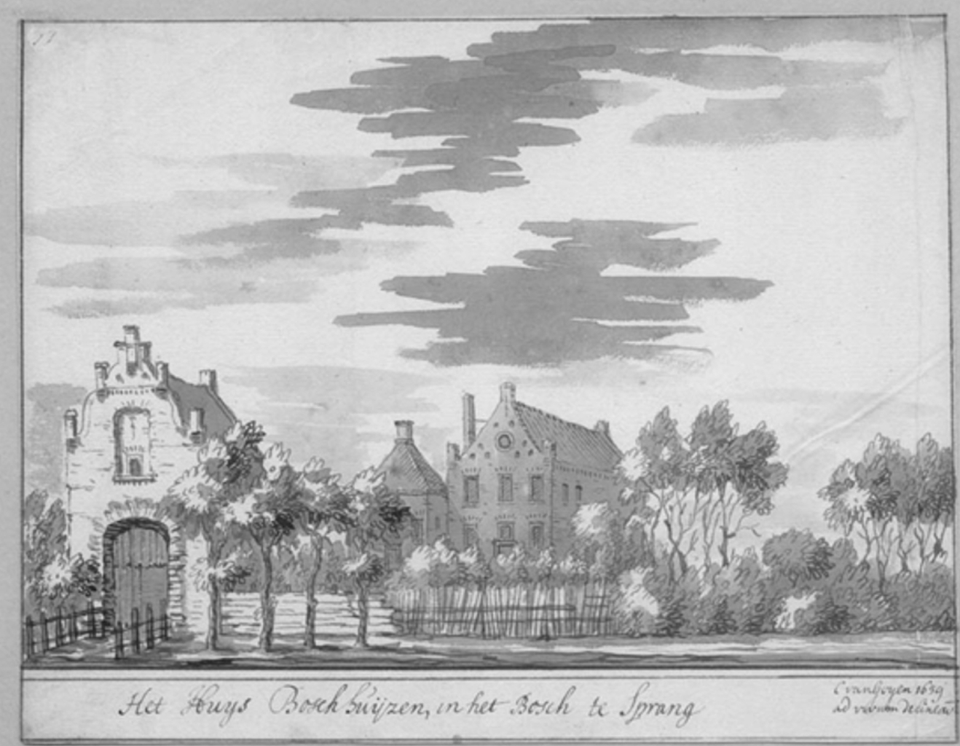Attention stone - Boschhuizen Castle
The concept of the "attention stone" was invented by Steven Woudstra from Schijndel. Over 250 of these tiles have now been placed in the Netherlands, Belgium and Germany. The purpose of these stones is to give visitors a moment to reflect on (lost) heritage. Through a QR code on the stone, visitors are linked to this website, where the complete cycling and walking route can be found that leads past all 24 stones in the region. The route is called "On the Trail in the Historic Langstraat. Three of the 24 tiles are located in Sprang-Capelle.
Boschhuizen Castle (1320-1790)
In Sprang, the old castle 'Boschhui...
The concept of the "attention stone" was invented by Steven Woudstra from Schijndel. Over 250 of these tiles have now been placed in the Netherlands, Belgium and Germany. The purpose of these stones is to give visitors a moment to reflect on (lost) heritage. Through a QR code on the stone, visitors are linked to this website, where the complete cycling and walking route can be found that leads past all 24 stones in the region. The route is called "On the Trail in the Historic Langstraat. Three of the 24 tiles are located in Sprang-Capelle.
Boschhuizen Castle (1320-1790)
Sprang used to have the old castle 'Boschhuizen', probably named after the forest surrounding it. It belonged to the craftsmen and was built around 1320, presumably by 'Foy van Wielensteijn', Lord of Sprang, a noble who enjoyed great prestige and played an important role in the region.The castle was a prominent structure on the 'Boschhuysensesteegh,' originally owned and occupied by the 'Van Boshuysen family,' said to be descended from William, the brother of Nicholas Craoul, Count of Grunes. This count was an important French nobleman and was captured by the English at Caen, Normandy, in 1346. It was his grandson William, who became the owner of the castle through purchase or inheritance and subsequently adopted the name 'Boschhuizen'. Around 1400, the castle came into the hands of the 'Van der Duyn family', through the marriage of Adam van der Duyn with Christina van Wielesteijn, heiress of Sprang. For 400 years the 'Van der Duyn family' resided in the castle as Lords of Sprang. In 1654 it was owned by Jacob de Jonge, Lord of Valckevoort (near Doeveren).
Importance
Castle 'Boschhuizen' was surrounded by a wide moat, which served as an additional protective measure. The location of the castle and the presence of the moat with drawbridge indicated the importance attached to security and independence.The location on the "Boschhuysensesteegh" was strategically chosen, giving the Lord of Sprang control over the surrounding areas and trade routes. Fortified structures not only provided protection, but also gave prestige and authority to the nobility and other powerful families who lived there. During the long period the castle existed, several Lords of Sprang were buried on the castle grounds. The castle was a family estate, where generations of the same noble family had a connection to the location. The Lords of Sprang lived there, ruled over the surrounding areas and eventually also found their final resting place within the castle walls. This burial place emphasized the emotional and symbolic value this place had for the residents.
Downfall
The castle was demolished around 1790. The demolition took place because the defensive function of the castle was no longer needed and its preservation became too costly. The moat was filled in 1825, this moat surrounded the entire castle grounds. The plot of the castle "Boschhuizen" was located at the corner of Eikenlaan - Molenstraat, with the castle building at the back right of the property and the tower to its left. Entrance gate and drawbridge were located on Molenstraat. At the time when there were no houses, a large circle of reeds grew on the existing fields, which just could not be removed. It must have been the castle's reed bed. Between 1950 and 1990 there was a children's playground on the castle grounds. During the construction of the houses on Oak Avenue, the castle moat was found on Mill Street with a wooden rowboat in it.
